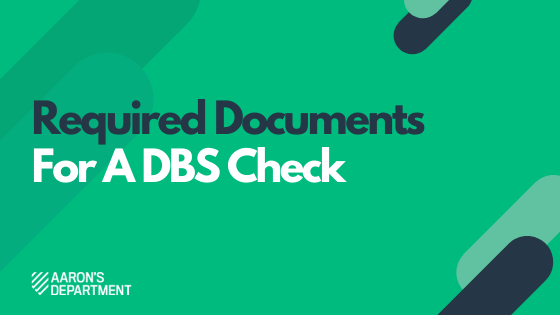Table of Contents
What Documents Are Needed For A DBS Check? – Document Groups
A bit of terminology before we start – when talking about document groups, “Group 1” refers to primary identity documents, “Group 2a” refers to trusted government documents, and “Group 2b” refers to Financial and Social History Documents”.
What Documents Are Needed For A DBS Check? – DBS Routes
You will need a selection of documents for a DBS Check, but the exact combination depends on what “route” is being taken. There are 3 routes and each represents a different combination of ID documents and checks. Ideally, applicants will follow route 1.
How to work out what documents are needed for a DBS check:
The documents the applicant will need to provide depend on the route the application takes. Route 1 would be the ideal route, but if this is not possible, it will go to Route 2 or 3.
Route 1
(UK Nationals and Non-UK Nationals)
Applicants must be able to provide:
- One document from Group 1.
- Plus 2 further documents from either Group 1, or Group 2a or Group 2b.
At least one of the documents must show the current address.
Non-UK Nationals applying for a DBS for paid work must use a version of Route 1, with a slightly different list of primary documents, which we’ll cover further down the page.
Route 2
(UK Nationals Only)
If the applicant doesn’t have any of the documents in Group 1, then they must be able to show:
- One document from Group 2a.
- Plus 2 further documents from either Group 2a or 2b.
At least one of the documents must show the current address. The organisation requesting the DBS check must then also use an appropriate ID validation service to check the application.
Route 3
(UK Nationals Only)
Route 3 can only be used if it’s impossible to process the application through Routes 1 or 2.
For Route 3, applicants must be able to show:
- A birth certificate issued after the time of birth (UK, Isle of Man and Channel Islands).
- One document from Group 2a.
- 3 further documents from Group 2a or 2b.
At least one of the documents must show the current address, and if the applicant can’t provide these documents, they may need to be fingerprinted.
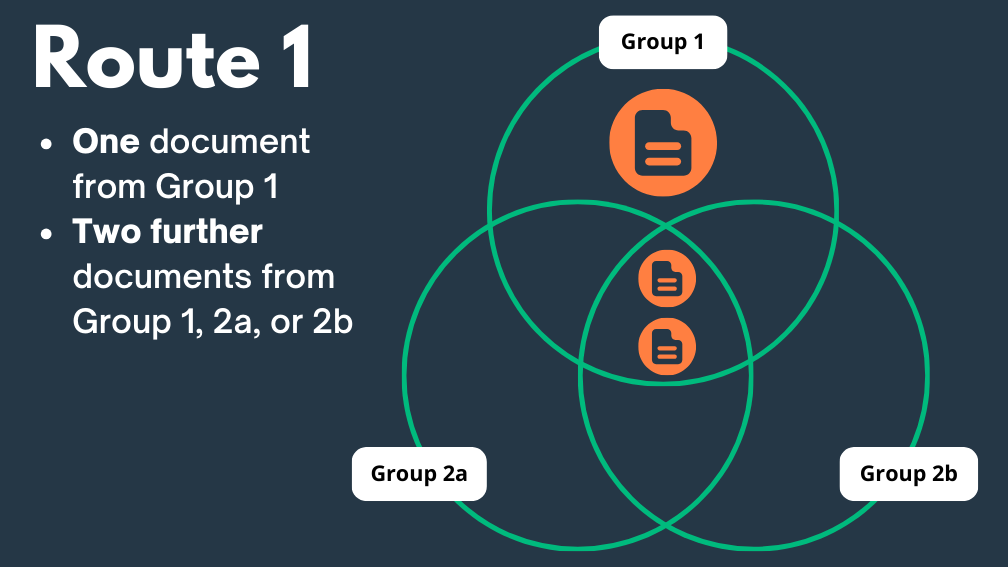

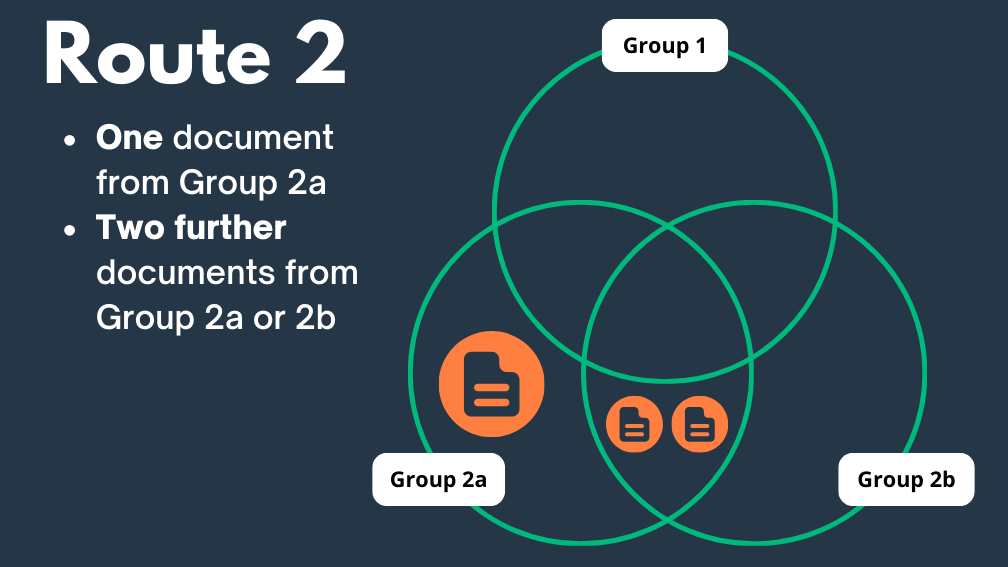

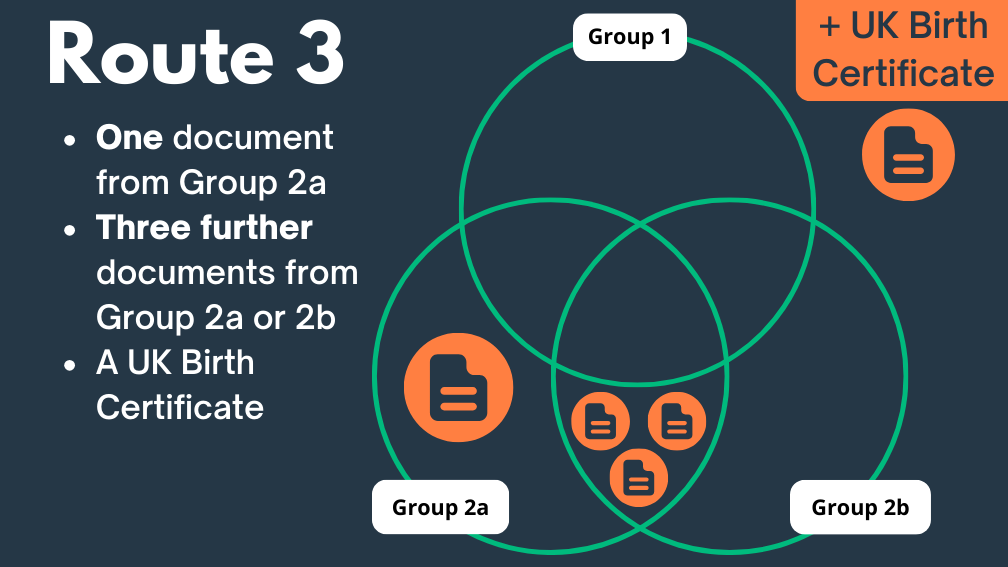

Please Note: All documents must be in the applicant’s current legal name, even if the document is still in-date and in use.
Group 1: Primary Identity Documents
| Documents | Notes |
|---|---|
| Passport | Any current and valid passport |
| Biometric residence permit | UK |
| Current driving licence photocard – (full or provisional) | UK, Isle of Man, and Channel Islands |
| Birth certificate – issued within 12 months of birth | UK, Isle of Man, and Channel Islands – including those issued by UK authorities overseas, for example embassies, High Commissions and HM Forces |
| Adoption certificate | UK and Channel Islands |
Group 2a: Trusted Government Documents
| Documents | Notes |
|---|---|
| Current driving licence photocard – (full or provisional) | All countries outside the UK (excluding Isle of Man and Channel Islands) |
| Current driving licence (full or provisional) | UK, Isle of Man, and Channel Islands |
| Birth certificate – issued after time of birth | UK, Isle of Man, and Channel Islands |
| Marriage/civil partnership certificate | UK and Channel Islands |
| Immigration document, visa, or work permit | Issued by a country outside the UK. Valid only for roles whereby the applicant is living and working outside of the UK. Visa/permit must relate to the non-UK country in which the role is based. |
| HM Forces ID card | UK |
| Firearms licence | UK, Isle of Man, and Channel Islands |
Group 2b: Financial & Social History Documents
| Documents | Notes | Issue Date & Validity |
|---|---|---|
| Mortgage statement | UK | Issued in last 12 months |
| Bank or building society statement | UK and Channel Islands | Issued in last 3 months |
| Bank or building society statement | Countries outside the UK | Issued in last 3 months – branch must be in the country where the applicant lives and works |
| Bank or building society account opening confirmation letter | UK | Issued in last 3 months |
| Credit card statement | UK | Issued in last 3 months |
| Financial statement, for example pension or endowment | UK | Issued in last 12 months |
| P45 or P60 statement | UK and Channel Islands | Issued in last 12 months |
| Council Tax statement | UK and Channel Islands | Issued in last 12 months |
| Letter of sponsorship from future employment provider | Non-UK only | Valid only for applicants residing outside of the UK at time of application. Must still be valid. |
| Utility bill | UK – not mobile telephone bill | Issued in last 3 months |
| Benefit statement, for example Child Benefit, pension | UK | Issued in last 3 months |
| Government, government agency, or council document giving entitlement, for example from the Department for Work and Pensions, the Employment Service, HMRC | UK and Channel Islands | Issued in last 3 months |
| EEA National ID card | Must still be valid | |
| Irish Passport Card | Cannot be used with an Irish passport | Must still be valid |
| Cards carrying the PASS accreditation logo | UK, Isle of Man, and Channel Islands | Must still be valid |
| Letter from head teacher or college principal | UK – for 16 to 19 year olds in full time education – only used in exceptional circumstances if other documents cannot be provided | Must still be valid |
Documents for Paid Working Non-UK Nationals
Non-UK Nationals must use route 1 if they are applying for paid work, and may not use any other routes. However, the list of acceptable documents is slightly different in this case. (If the non-UK national will be doing voluntary work, Route 1 can be completed the regular way.)
Applicants must provide one ‘Primary Document’ from the list below, along with a further two documents selected from Group 1, Group 2a, or Group 2b.
| Documents and details |
|---|
| A current passport or passport card showing that the holder is a national of Ireland. |
| A current document issued by the Home Office to a family member of an EEA or Swiss citizen, and which indicates that the holder is permitted to stay in the United Kingdom indefinitely. |
| A current Biometric Immigration Document (Biometric Residence Permit) issued by the Home Office to the holder indicating that the person named is allowed to stay indefinitely in the UK, or has no time limit on their stay in the UK. (This can’t be used as a secondary document if it’s already being used as a primary document in this section.) |
| Online evidence of immigration status. Either via the View and Prove service or using the BRP or BRC online service. Issued by the Home Office to the employer or prospective employer, which indicates that the named person may stay in the UK and is permitted to do the work in question. Must be valid. Note: this includes the EUSS digital status confirmation. |
| A current passport endorsed to show that the holder is exempt from immigration control, is allowed to stay indefinitely in the UK, has the right of abode in the UK, or has no time limit on their stay in the UK. |
| A current Immigration Status Document issued by the Home Office to the holder with an endorsement indicating that the named person is allowed to stay indefinitely in the UK or has no time limit on their stay in the UK, together with an official document giving the person’s permanent National Insurance number and their name issued by a government agency or a previous employer. |
| A current passport endorsed to show that the holder is allowed to stay in the UK and is currently allowed to do the type of work in question. |
| A current Biometric Immigration Document (Biometric Residence Permit) issued by the Home Office to the holder which indicates that the named person can currently stay in the UK and is allowed to do the work in question. |
| A current document issued by the Home Office to a family member of an EEA or Swiss citizen, and which indicates that the holder is permitted to stay in the United Kingdom for a time limited period and to do the type of work in question. |
| A frontier worker permit issued under regulation 8 of the Citizens’ Rights (Frontier Workers) (EU Exit) Regulations 2020. |
| A current Immigration Status Document containing a photograph issued by the Home Office to the holder with a valid endorsement indicating that the named person may stay in the UK, and is allowed to do the type of work in question, together with an official document giving the person’s permanent National Insurance number and their name issued by a government agency or a previous employer. |
| A document issued by the Home Office showing that the holder has made an application for leave to enter or remain under Appendix EU to the immigration rules on or before 30 June 2021 together with a Positive Verification Notice from the Home Office Employer Checking Service. |
| An Application Registration Card issued by the Home Office stating that the holder is permitted to take the employment in question, together with a Positive Verification Notice from the Home Office Employer Checking Service. |
| A Positive Verification Notice issued by the Home Office Employer Checking Service to the employer or prospective employer, which indicates that the named person may stay in the UK and is permitted to do the work in question. |
What Documents Are Needed For A DBS Check: Application Info
What personal information does the application require?
DBS check applicants must be able to provide the following information:
> Title
> Forename
> Middle Names (if any)
> Surname
> Previous Names (any names they have been known by before)
> Date of Birth
> Place of Birth
> Gender
> Current Address
> At Least 5 Years Previous Address History (with no gaps)
Alternatively, using our online DBS application system, you can create an account for the applicant, and let them fill out the DBS application form themselves!
Applicants Who Have Been Adopted
If the applicant was adopted before the age of 10, they do not need to provide their surname at birth. This is because the age of criminal responsibility is deemed to be 10 years, under the Children and Young Persons Act 1933, Chapter 12, Section 50.
This means that there is no possibility that an individual could have a criminal record in a name that was used until the age of 10.
Applicants With No Surname
If the applicant has no surname, they must enter their forename in both the forename and surname sections of the application.
In some parts of the world, having no surname isn’t particularly unusual, so don’t let it put you off. The majority of our no-surname applicants are from India, and it never causes any issues with their DBS checks.
What Documents Are Needed For A DBS Check? – Checking for Indicators of Fraud
Always check for signs of tampering when checking identity documents. Documents should be queried if they display any signs of damage, especially in the areas of personal details such as the name and the photograph.
The following guidelines should help you look out for any suspicious signs when authenticating documents. The National Document Fraud Unit (NDFU) in the Home Office has published guidance on examining identity documents to detect basic forgeries.
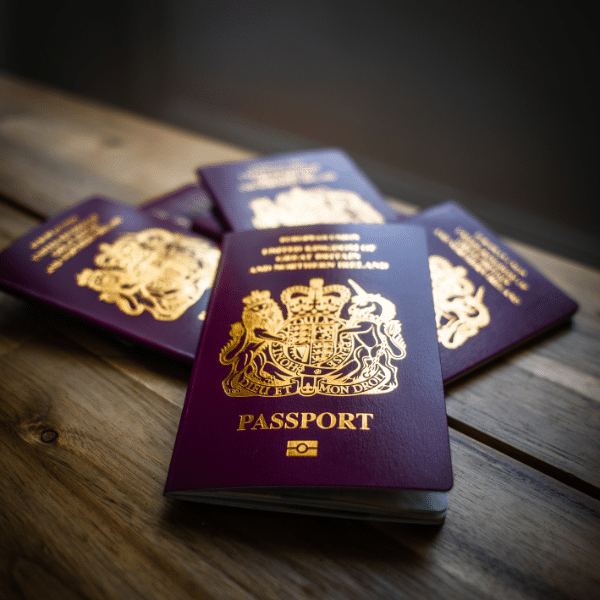

Checking a Passport
- Check the general quality and condition of the passport. Treat it with suspicion if it is excessively damaged; accidental damage is often used to conceal tampering.
- Photographs should be examined closely for signs of damage to the laminate or for excessive glue or slitting of the laminate; these signs would indicate photo substitution. If the photograph appears excessively large, this might indicate an attempt to hide another photograph underneath. There should also be an embossed strip embedded into the laminate, which will catch a portion of the photograph.
- Check there is no damage to this area. These procedures apply to all nationalities of passport.
Checking Driving Licences
- Do not accept licences, other than those stated in the list of valid identity documents.
- Examine the licence for evidence of photo tampering or any amendment of the printed details.
- English, Welsh and Scottish driving licence numbers contain information about the applicant’s name, sex and date of birth. This information is written in a special format, but can be matched against the information provided by the applicant. If the information doesn’t match, the licence is invalid as a piece of evidence (at Aaron’s Department, our system checks for this automatically).
- Please note that the date of birth on English, Welsh and Scottish driving licences, issued before 1977, is not recorded as a separate entry on the licence. The date of birth can be deciphered from the driving licence number and checked against the date of birth field on the application form.
- For Northern Ireland, Isle of Man and Jersey driving licences, the licence number is in a different format. This means the validation method, shown adjacent, cannot be used.
For example, the format of the number for Christine Josephine Robinson, born 2 July 1975
R O B I N 7 5 7 0 2 5 C J 9 9 9 0 1
N N N N N Y M M D D Y I I C C C C C
N = first 5 letters of the surname (if the surname begins MAC or MC it is treated as MC for all)
Y = year of birth
M = month of birth (in the case of a female, the number represented by the first M will have the value 5 added to the first digit, for example, a female born in November (i.e. 11) would display ‘61’ in the MM boxes or if born in February (i.e. 02) would display ‘52’)
D = day of the month of birth
I = initial letter of the first two forenames – if only one, then 9 will replace the second letter – if the licence indicates that the applicant has a middle name, ensure that one has been provided in Section A
C = computer generated
Checking an Old-Style Driving Licence (no photograph)
- Remove the document from the plastic wallet and check that it is printed on both sides.
- It should have a watermark visible by holding the licence up to the light, and there should be no punctuation marks in the name or address.
- The ‘Valid To’ date should be the day before the bearer’s 70th birthday (unless the bearer is already over 70). Therefore, it can be cross-referenced with the applicant’s date of birth, detailed in Section A.
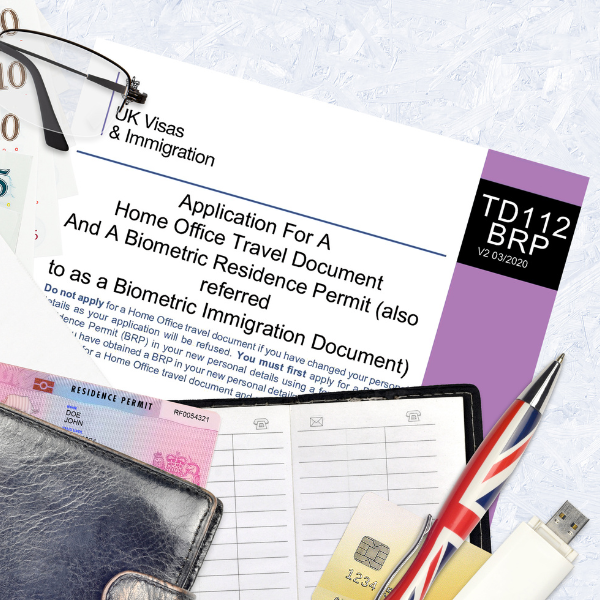

Checking Online Evidence of Immigration Status
Ensure that evidence is always taken from a .gov.uk web address. Further information on how to view evidence of immigration and right-to-work status can be found here.
Checking a Biometric Residence Permit
View the features of a permit and how to check a job applicant’s biometric residence permit, seeing if they have a right to work in the UK.
Checking a Birth Certificate
Birth certificates are not evidence of identity, and are easily obtained. Although certificates issued at the time of birth may give more confidence that it belongs to the individual, unlike a recently issued certificate, they will not show if any information has been corrected or superseded by a new registration.
Check the quality of paper used; genuine certificates use a high grade. There should be a watermark visible when the document is held up to the light. Any signs of smoothness on the surface would indicate that the original text might have been washed or rubbed away. There should be no signs of tampering, changes using liquid paper, overwriting or spelling mistakes.
For more information on checking birth certificates, please refer to Her Majesty’s Passport Office document General Register Office guide to birth certificates.
The following list provides some general information which may help to establish whether the certificate and/or the details have been falsified:
– The certificate format used should be appropriate for the year of registration.
– Only the surname should be entered in upper case, not the forename(s).
– Dates of birth should be shown with the day and month in words and the year in figures.
– Spacing between falsely added particulars might be too wide or narrow compared to original information.
– False particulars may not be aligned with other words.
– Characters may not be of the same size or shape as the rest of the particulars.
– Changes might not be consistent, e.g. parents’ surnames might be altered, but not the signatures.
– The area around falsely added or removed particulars may react differently under ultraviolet light, i.e. show signs of staining – in addition, such areas of paper may appear thinner where the paper fibres have been disturbed by abrasion.
Checking a Firearms Licence
Check the licence is printed on blue security paper with a Royal crest watermark and a faint pattern stating the words ‘Home Office’.
Examine the licence for evidence of photo tampering or any amendment of the printed details, which should include home address and date of birth.
The licence should be signed by the holder and bear the authorising signature of the chief of police for the area in which they live, or normally a person to whom his authority has been delegated.


Other Types of ID
- Examine any photo cards for evidence of photo tampering or any amendment of the printed details.
- Ensure all letters and statements are recent, i.e. within a three-month period.
- Do not accept documentation printed from the internet.
- Check letter headed paper is used, bank headers are correct, and all documentation looks genuine.
- The address should be cross-referenced with that provided by the applicant.


What To Do If You Suspect False Identity or Documents
If you suspect that you have been presented with a false identity or documents at the time of application, do not proceed with the application process. You should report suspected identity fraud through the Action Fraud website. Further information on identity fraud can be found on the Metropolitan police website.
Under Section 8 of the Asylum and Immigration Act 1996, all employers in the United Kingdom are required to make basic document checks to help prevent anyone from working illegally. By carrying out checks, employers will be able to establish a defence for themselves if any of their employees are found to be working illegally at a later date. Further details are available on the UK visas and immigration website or by calling the employer helpline on 0845 010 6677.
Summary – What Documents Are Needed For A DBS Check?
Hopefully this page has got you up to speed with what documents are needed for a DBS check. However, if you need any more assistance with the DBS process, our website is packed with detailed guidance on all aspects of the DBS checking process.
Our team of DBS experts are also available to answer questions if you’ve still got any! Our fast, simple, and affordable online DBS system processes hundreds of DBS applications for organisations like yours every day. If you’re interested in checks for your staff, or have any questions, feel free to get in touch at contact@aaronsdepartment.com or call 0113 877 0171.
Forward this page!
Related Content
We hope you have found our article, “What Documents Are Needed For A DBS Check?” informative, the linked pages below might also be handy:
- The Perks Of Using The Update Service
- Viewing your DBS status online
- What Documents Do You Need For A Right To Work Check?
About The Author


John Schofield-Antoncich
John has processed more applications than days he has been alive, and has become the DBS expert. Got a question? He knows the answer!
